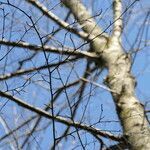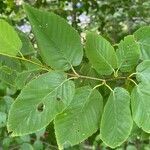Tree to 25 m, the smooth, reddish-brown bark exfoliating in thin layers, eventually becoming rough, with large, thickened, loose-edged plates on large trees; crushed twigs with a strong flavor of wintergreen; lvs ovate or ovate-oblong, 5–10 cm, acute or short-acuminate, very finely and sharply serrate, rounded to subcordate at base, appressed-villous on the veins beneath; lateral veins 9–12 pairs, impressed above; fruiting catkins sessile or nearly so, short-cylindric to ellipsoid or somewhat obovoid,2–3 cm; scales glabrous, 5–7 mm, the middle lobe somewhat prolonged, the oblong lateral lobes divergent or ascending; frs broadly triangular-obovoid, 2.4–3 mm and about as wide, the body half as wide; 2n=28. Moist woods; s. Me. and s. Que. to Del., O., and Ky., and in the mts. to Ga. and Ala. (B. uber (Ashe) Fernald, a striking variant in Smyth Co., Va., with rounded lvs 2–4 cm, and 3–6 pairs of lateral veins)
More
A deciduous tree. It grows 15 m tall and spreads 12 m wide. It can be 20-25 m high. The bark is red-brown with pale lenticels across is. The bark becomes dark and furrowed. The leaves are oval and 12 cm long by 6 cm wide. They taper to the tip and have sharp teeth. They are glossy and dark green above and paler with silky hairs underneath. They turn yellow in autumn. The buds are mostly without hairs. The male and female flowers are in separate catkins. Male ones are 7.5 cm long and yellow and drooping. The female ones are green and upright. They occur separately on the same plant. The fruit is a catkin which breaks up when ripe.
The inner bark is eaten fresh or dried for later use. It is also used for tea. The leaves and twigs have an oil and they are used to brew a tea. The leaves are dried and used for tea. The sap is also drunk. It can also be converted into vinegar. It is fermented into beer. An essential oil distilled from the twigs and bark is used as a wintergreen flavouring in soft drinks and desserts and puddings.




